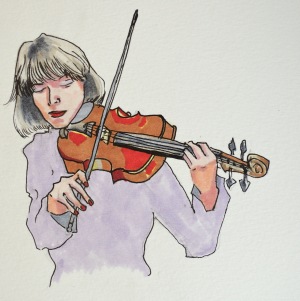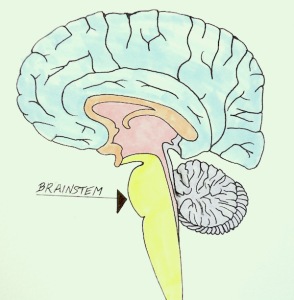Imagine the following. You have been paid an exorbitantly small fee to participate in an experiment at your local university. You are brought into the testing room, and the experimenters pull a stretchy cap of electrodes over your head. They show you a big needle full of green gel (“Now, this won’t hurt a bit!”) and start injecting the gel through the small holes in the cap, right on your hair. This goes on for quite a while. After this contraption called an electroencephalogram (EEG) is all set up, you are told to listen to a recording of words (minute, eon, moose, hammer). The electrical energy from the centre of your brain is recorded as you listen.
The EEG cap is pulled off your head and you are sent into an adjoining room to wash your hair. It takes a long while to get the gel out. Meanwhile, your friend Linda is brought into the room. The electrical energy that was recorded from your brain is played back to Linda, who never heard the original recording. Linda listens closely, hesitates, and then says, “Minute, eon, moose hammer.” She can identify the words that you were listening to, solely from the recordings of your brain.
This recording is called the frequency following response, and is produced by nuclei in the brainstem, an ancient part of the brain buried deep in the middle of your skull. The frequency following response imitates any sounds that you hear. Using different components of a sound, it can create the individual quality produced by any noise.
Scientists started reporting these phenomena in 1980, although a similar type of recording could be obtained from the cochlea since 1930. However, it was only recently that the frequency following response was used to give researchers insight into individual differences that might exist between our auditory abilities. Differences that might not just be inbuilt, but also learnt.
Over the last two decades, research has indicated that the brains of musicians are different from the brains of non-musicians. On one level, this is a bit of a meaningless statement. Musicians practise for many years to perform at a professional level, and their practice hones visual attention, listening skills, and motor movements. If we accept that we are a reflection of our brains, then of course brains are going to change to reflect this occurrence. (Which is why we shouldn’t pay too much attention to news articles, or ads, that proclaim in glorious typeface that ten grams of ginseng root or ten minutes a day of chess changes the brain. Brains change every time you learn something!)
But what is common sense to us wasn’t common sense to neuroscience thirty plus years ago. Back then our brains were considered to be relatively hardwired: like a Christmas present from a distant aunt, you had to accept what you were given. Likewise, it was thought that the space in our brains dedicated to certain activities would stay that way. Your visual cortex would process vision. Your somatosensory system would process touch. The space for sensation on your left pinky finger would always, and only, process sensation from that area. Once a goal defence, always a goal defence.
In the 1980s, Dr. Michael Merzenich conducted some ground-breaking research on these mental ‘maps’ that made the scientific community take notice of the changing brain. Merzenich severed the median nerve of a monkey’s hand, thereby removing all sensation in the middle of the hand. When he checked back a few months later, he noticed an incredible mental feat: the space that had been reserved for that part of the hand had been invaded by the mental maps of the surrounding areas. There was open real estate in the brain, and the neighbouring networks had jumped at the chance to expand their back yards and build some tennis courts. This discovery led to a plethora of interest in the changing brain, dubbed neuroplasticity. The history of neuroplasticity research is documented in Norman Doige’s book The Brain That Changes Itself. If you haven’t read it, I recommend you purchase and digest this book immediately.
In humans, because of something called ‘Ethics’, it’s not possible to sever the connection between hand and brain willy-nilly. To understand human neuroplasticity, it’s often necessary to observe changes in ability, and infer the neuroplastic process that may have led to this change (sometimes using non-invasive neuroscience tools such as EEG, or functional magnetic resonance imaging).
Music training is a useful way to investigate neuroplasticity in humans. This is because it involves a population who have had intense and similar training over a period of many years. Incredibly, studies of the brain have indicated that musicians have differences in the size of certain brain areas, in the “activity” of brain regions, and in the tracts that connect parts of the brain.
But the idea of echoes in the brain really caught my interest. Perhaps its most extraordinary feature is what it does not require in order to function perfectly effectively: namely, attention. Yes, that’s right. The frequency following response is an automatic response that doesn’t require attention. It doesn’t even need consciousness: a sleeping body will produce exactly the same recording. This has been described as a true preconscious index of neural behaviour, reflecting the present state of an individual’s neural system, formed throughout a life of aural experience and learning.
Researchers investigating this phenomenon, and the impact that music ability has on it, include Nina Kraus, Gabriella Musacchia, Alexandra Parbery-Clark, and Erica Skoe, all from Northwestern University, Illinois. Though preliminary, their research gives promising indications of the benefits of active engagement in music. These benefits might have positive impacts not just on musical ability, but on the holy grail of neuroplasticity research: transfer of the skills learnt from one area to a seemingly unrelated area. In this case, the possibility of music training to improve language and reading skills.
In general, studies have indicated that the brainstem of musicians shows a faster neural response to sounds, a more similar neural representation of the sound, and a stronger encoding of the sound’s frequency, which essentially means that musicians have better pitch perception. This change has been found for both musical tones and, astonishingly, for aspects of language. For example, Gabriella Musacchia and her colleagues conducted a 2007 study on sixteen musicians and thirteen non-musicians. They found that musicians had both earlier and larger brainstem responses to both speech stimuli (the syllable ‘da’) and music stimuli (the synthesised sound of a cello bowing middle G). And the more musical training someone had, the stronger their encoding of pitch.
A follow-up study by Alexandra Parbery-Clark and colleagues investigated the abilities of musicians and non-musicians to hear speech in noise. Musicians were found to retain a more similar representation of sounds in noise than non-musicians, and importantly, there was a relationship between the similarity of the echo and performance on a popular test of hearing in noise. This might mean that musicians are better at extracting meaningful information from a noisy environment. Unfortunately, my twelve years of classical flute training doesn’t seem to have helped with this — I’m constantly asking people to repeat themselves. But I could be the outlier in this situation.
The studies listed above, and in fact most of the research in this area, are cross-sectional — meaning two different groups are tested concurrently. Because of this, it’s not possible to infer that music training has caused improvements in hearing or pitch. You could just as easily say that people with better hearing and pitch discrimination are more predisposed to pursue a musical career. To claim a causal connection between musical training and neuroplastic changes in ability, it is necessary to design a study with a few important features. Firstly, you need to test the same participants over multiple occasions. This is so you can see whether the change took place during the period of testing. Secondly, there must be an experimental manipulation at the beginning of the study — in this case, giving people music lessons. Finally, there must be another group who is identical in every respect, but did not receive the treatment.
There have only been few studies that have met these requirements in this area of research. One has been conducted by Nina Kraus and her colleagues. They split children into two groups: one was given violin lessons, and one was given music appreciation classes, where they were taught about music but did not learn an instrument. They found that after training, the children who learnt violin showed faster and stronger brainstem responses to speech, relative to children who only had music appreciation classes. This is particularly fascinating because the group with music appreciation had heard music, but had not learnt to play music. Why could this be?
Imagine, if you will, scrubbing the majority of the green gel out of your hair, and drying it enough that you’re not causing a flood as you leave the experimental chamber. It so happens that you’re a keen melodica player, and have a music lesson scheduled right after the experiment, so head over to your teacher’s office. Mr S. Armstrong, possibly the finest melodica player in your local town, is keen to teach you a new opus. He plays it to you first, and then shows you the sheet music as you attempt it for yourself.

You look at the sheet music and, and the little black dots and lines tell you what you need to play. You press the corresponding keys on the melodica, and can instantly hear back the music. You play for a few seconds, and then oops, a mistake! You wince, adjust your hands, and play the note again. This time, yes, correct! You concentrate as hard as possible, and make it through the rest of the music with no errors. Mr Armstrong smiles. “Wonderful work. You’ll be playing at Carnegie Hall before you know it.”
It’s possible that the embodied aspect of music training — vision, motor movement, hearing, and instant feedback — all come together to benefit someone who is taking music lessons over someone who’s just learning about music. This may produce neuroplastic change in the brainstem, through a not-fully-understood, slightly complicated process, that is described at the bottom of this article for those who are interested.*
In the longitudinal study described above, there was no improvement in reading fluency in the group who learnt violin. This is an interesting finding, considering the potential benefits to language discussed above — that people have a stronger brainstem representation of speech sounds and a better ability to to make out words in noise. It’s possible that one year of lessons wasn’t enough time to result in an improvement in reading, and that the “dose” just needed to be bigger. It’s also possible that the small number of participants in the study — nine children given violin lessons and ten children given music appreciation — made it impossible to detect a small or medium effect. More longitudinal research, with larger sample sizes, is clearly necessary to further investigate these possibilities.
Research into the brain and mind is endlessly fascinating. It can teach us more about the potential we have to change and grow, throughout our lives. And it can reveal the peculiarities of old, odd little parts of the brain. In this case, the brainstem produces a constant recording of any sounds we hear. This recording goes unnoticed by us, and can even be produced while we’re sleeping. What its functions are, we have yet to really know. But music training makes it stronger.
*Okay, so you’re particularly interested in the technical nature of why the brainstem might be plastic. That’s great, so…in a nutshell, it’s not fully understood. However, a pathway called the “corticofugal system” has been proposed as a likely candidate. Bundles of neurons in the brainstem, called nuclei, are involved in sending bottom-up messages from the cochlea to the primary auditory cortex and association areas, as well as receiving top-down messages from these areas. Research indicates that the bottom-up corticofugal fibres work to selectively enhance processing of auditory information that has been emphasised through previous experience and learning. For musicians, embodied sensorimotor practice may improve the ability to encode sound patterns, which may then enable the auditory system to selectively enhance familiar aspects of the stimulus in the brainstem.
For further reading (and I have lots more if you’re interested!) see:
Galbraith, G. C., Arbagey, P. W., Branski, R., Comerci, N., & Rector, P. M. (1995). Intelligible speech encoded in the human brain stem frequency-following response. Neuroreport (Vol. 6). —> this is the paper where I found the stimuli presented at the start of my article!
Kraus, N., & Chandrasekaran, B. (2010). Music training for the development of auditory skills. Nature Reviews. Neuroscience, 11(8), 599–605. http://doi.org/10.1038/nrn2882 —> This is a fabulous overview of the literature.
Kraus, N., Slater, J., Thompson, E. C., Hornickel, J., Strait, D. L., Nicol, T., & White-Schwoch, T. (2014). Auditory learning through active engagement with sound: biological impact of community music lessons in at-risk children. Frontiers in neuroscience, 8. —> This is the longitudinal study of active music training mentioned in my post.
Musacchia, G., Sams, M., Skoe, E., & Kraus, N. (2007). Musicians have enhanced subcortical auditory and audiovisual processing of speech and music. Proceedings of the National Academy of Sciences of the United States of America, 104(40), 15894–8. http://doi.org/10.1073/pnas.0701498104 —> This is the study mentioned above, indicating that musicians had earlier and larger brainstem responses to speech and music stimuli.
Parbery-Clark, A., Skoe, E., & Kraus, N. (2009). Musical experience limits the degradative effects of background noise on the neural processing of sound. The Journal of Neuroscience, 29(45), 14100–7. http://doi.org/10.1523/JNEUROSCI.3256-09.2009 —> This is another study mentioned above, about the improved ability of musicians to discriminate sound in noise.

